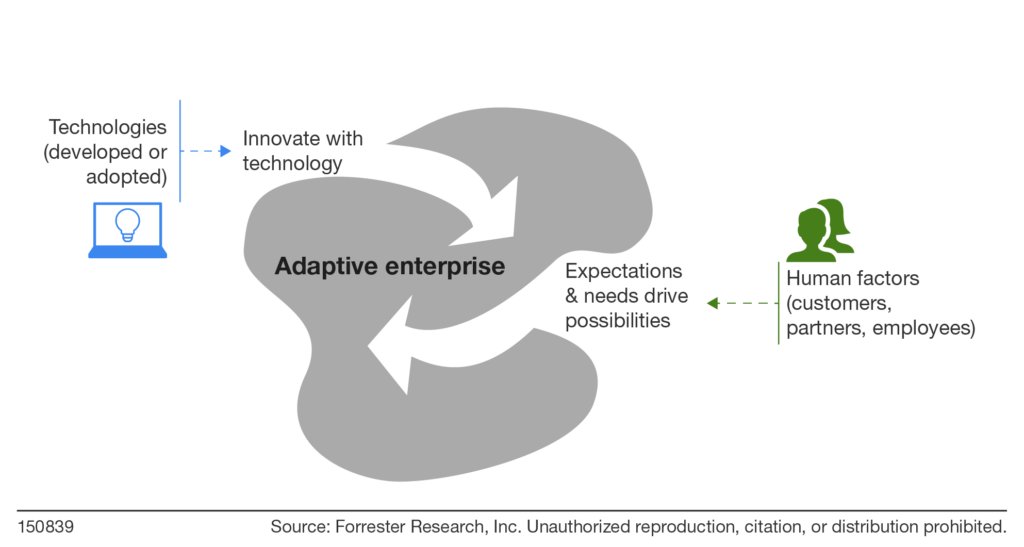Think Adaptive For The 2020s
The COVID-19 pandemic has led us to use many descriptive words and phrases: the new normal, resiliency, business agility, adaptability, and flexibility. These permeate the news and executive conversations. I think adaptive best describes the future of successful business; here is why . . .
Adaptive Is A New Spin On An Old Idea
We first heard adaptive in Professor Gary Hamel’s 2012 book, What Matters Now: How to Win in a World of Relentless Change, Ferocious Competition, and Unstoppable Innovation. He defined it as:
” . . . the capacity to reconfigure [the firm’s] underlying business concept, by dramatically rethinking its core mission, its primary value proposition, its core competencies, the markets or industries in which it competes, [and] its end customer . . . “
We like Prof. Hamel’s definition because it’s about a firm’s capacity to change. We also like his characterization of the effort as a “dramatic rethinking.” While firms have been adapting as long as there has been business, we think his definition asserts a proactive preparation for the future: It’s beyond evolving out of necessity. That’s the new spin, which 2020 has put an exclamation on.
Forrester’s Adaptive Strategy Is A Way To Prepare
In our May 2019 report, “Beyond Agility — Adaptive Enterprises Hold The Winning Hand,” we laid a foundation for an adaptive strategy. The idea was simple: Successful businesses will focus less on accurately predicting future years in advance. Instead, they will become the kind of company that can adapt as events unfold. We came up with the idea of an “amoeba” organization that shifts its shape in response to the dual pressures of customers and technologies. These amoebalike adaptive firms will carefully balance preparing for the unexpected and thoughtfully rethinking the present.

In the summer of 2019, we found that more adaptive firms were growing 3x faster than their competitors. We further identified three ways these firms lead markets that go beyond just being flexible (or agile):
- They were already customer-obsessed but emphasize building and participating in ecosystems as a way to express it.
- Their technology is based on platforms, and they disruptively innovate with emerging technologies that benefit from exponential trends such as Moore’s law.
- They have organizations that are future-fit in terms of talent, culture, and work automation.
What we didn’t anticipate was the 2020 exclamation point! Today, I’m seeing the word “adaptive” surface in the conversations of Jeff Bezos (head of arguably the world’s most adaptive company). I also heard it from Arvind Krishna, CEO of IBM, another company that has adapted many times over its long history. The next time you listen to a top business leader, listen for adaptive ideas. I think you will hear plenty.
We’ve Written A Lot About Adaptive Already
Forrester has put together lots of research on the adaptive strategy since mid-2019. Here are a few offerings from that time that are free to nonclients. Many others are on Forrester.com.
Courage Required: The CIO’s Role In Building An Adaptive Enterprise
Forrester eBook: The Adaptive Enterprise
Build An Adaptive Workforce For Customer Obsession
We Invite You To Join Us As We “Adapt” Adaptive
As a result of the COVID-19 pandemic, we are refining the adaptive strategy even more to accommodate the ideas of uncertainty, resiliency, and outcome-based investing. Specifically, we see:
- The necessity of mastering uncertainty, not just managing risk. Uncertainty is a special kind of risk, according to Frank Knight, who wrote about it in 1921. His work led to the term Knightian uncertainty. This term describes risks that are difficult to anticipate, quantify, or “manage” in the traditional sense. Today’s leaders are excellent risk-takers, even though some have played loose with our privacy. Tomorrow’s leaders will be masters of uncertainty. As one C-level executive told us recently, he intends to not just survive uncertain times; his vision is to become the kind of company that does better the more uncertain times become. What would it take to make your business that way?
- The consideration that resiliency is elemental to corporate value. The term “resiliency” has received its fair share of buzz since March, and it is closely related to uncertainty. A resilient business is built to respond and recover from unpredictable events. Today, investors value companies based on estimated future earnings and some amount of quantified risk, but they don’t consider Knightian uncertainty. We think they will, going forward. Bluntly, the adaptiveness (and resiliency) of public companies will translate directly into the value of their stock price.
- The shift toward business-outcome-based investments. This is a fairly new idea we are developing, but the gist is this: Many firms still invest in transformation and technology using return-on-investment calculations. Soft benefits are heavily discounted. Adaptive firms are learning to invest differently. They define outcomes that meet customer needs or mitigate risks now or in the near future and invest to achieve those outcomes. This helps them adapt more easily as things change. It also allows them to invest in building resilient systems and architectures that enable future options.
Bobby Cameron and I are leading a collaboration to further define our adaptive strategy for its customer-obsessed maturity. We are also looking at what makes a future-fit CIO. Finally, I’m thinking about a research piece on the six disciplines of highly adaptive enterprises as a set of principles and case studies of firms that are built for the future.
